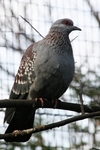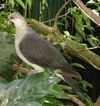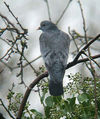Genus Columba
White-naped Pigeon - Its natural habitats are subtropical or tropical moist lowland forests and subtropical or tropical moist montanes. It is threatened by habitat loss.
White-collared Pigeon - The species is endemic to the Ethiopian highlands in Eritrea and Ethiopia. It occupies countryside surrounding rocky cliffs and gorges. Also common in town centres
Silvery Wood-Pigeon - The Silvery Pigeon , also known as Silvery Wood-pigeon or Grey Wood-pigeon is a species of pigeon. It was thought to be extinct but photographs taken in 2008 near Masokut Island might represent this species.
African Olive Pigeon - This is a species of cool, moist forest canopies above 1,400 m altitude, although it occurs locally as low as 700 m. It will use mountain fynbos, second growth and clearings, and feed on agricultural land when not persecuted.
Bolle - It is a resident breeder in the mountain laurisilva forest zone. Bolle's Pigeon builds a stick nest in a tree, laying one white egg.
Columba duboisi - The Réunion Pink Pigeon is an extinct species of pigeon that formerly lived on the Mascarene island of Réunion. It is known from the description of a rusty-red pigeon given by Dubois in 1674 and a single subfossil humerus that agrees with that of the Pink Pigeon of Mauritius in generic characteristics, except being slightly longer. Also, Dubois' reference to the bill being red at the base and the eyes being surrounded by a red ring suggest that this species was closely allied to the Mauritus taxon.
Nilgiri Wood Pigeon - The Nilgiri Woodpigeon is large pigeon found in the moist deciduous forests and sholas of the Western Ghats in southwestern India. They are mainly frugivorous and forage in the canopy of dense hill forests. They are best identified in the field by their large size, dark colours and the distinctive checkerboard pattern on their nape.
Yellow-eyed Stock Dove - It breeds in southern Kazakhstan, Uzbekistan, Turkmenistan, Tajikistan, Kyrgystan, Afghanistan, north-east Iran and extreme north-west China. It winters in north-east Pakistan and Jammu & Kashmir in India.
Rock Pigeon - This species builds a large stick nest in a tree and lays two white eggs. Its flight is quick, with the regular beats and an occasional sharp flick of the wings which are characteristic of pigeons in general.
Speckled Wood Pigeon - The upper body of the Speckled Wood-pigeon is maroon-brown except for its neck, which, like many pigeons, is iridescent. Its lower body features the speckles which give it its name. The bird is 38 centimeters in length.
Black Wood Pigeon - Its natural habitats are temperate forests and subtropical or tropical moist lowland forests. It is becoming rare due to habitat loss.
Ryukyu Wood Pigeon - The Ryukyu Wood-pigeon , otherwise known as the Silver-banded or Silver-crescented Pigeon is an extinct species of pigeon that was endemic to islands in the Okinawa archipelago south-west of the Japanese mainland. In the Okinawa group, it has been recorded from Iheyajima, Izenajima, Okinawa proper and the nearby islet Yagachijima. In the Kerama Retto to the west of Okinawa, it was found on Zamamijima, whereas in the Daitō group, some 300 km to the SE of Okinawa, it occurred on both major islets, Kita Daitōjima and Minami Daitōjima. In earlier times, it was most likely also found on other islands near Okinawa, such as Iejima. The species' scientific name honors Stejneger's friend, the specimen collector Pierre Louis Jouy.
Laurel Pigeon - A rare resident breeder in the mountain laurisilva and Canary pine forests, the Laurel Pigeon builds a stick nest in a tree. There it lays one white egg.
White-headed Pigeon - The pigeon's habitat is from Cooktown, Queensland to southern New South Wales. It can commonly be found in tropical regions, subtropical rainforest, scrub, watercourses and street trees. Since colonisation of Australia, their numbers have decreased but they have thrived on the introduced Camphor laurel .
Carrier pigeon - Wild Rock Pigeons are pale grey with two black bars on each wing, although domestic and feral pigeons are very variable in colour and pattern. There are few visible differences between males and females.
Stock Dove - In the northern part of its European and western Asiatic range the Stock Pigeon is a migrant, elsewhere it is a well distributed and often plentiful resident.
Somali Pigeon - Its natural habitat is temperate grassland.
Yellow-legged Pigeon - Its natural habitats are subtropical or tropical moist lowland forests and subtropical or tropical moist montane forests. It is threatened by habitat loss.
Andaman Wood Pigeon - It is threatened by habitat loss.
Common Wood-Pigeon - In the colder northern and eastern parts of its Europe and western Asia range the Common Wood Pigeon is a migrant, but in southern and western Europe it is a well distributed and often abundant resident.
Comoro Olive Pigeon - Its natural habitat is subtropical or tropical moist montane forests. It is becoming rare due to habitat loss.
Ashy Wood Pigeon - Its natural habitat is temperate forests.
Pale-capped Pigeon - It is a 36-40.5 cm long, large, all-dark pigeon with a contrasting pale crown. The male has whitish-grey crown, purplish-maroon upperparts with faint green gloss on neck, more strongly iridescent mantle and back, dark slate-coloured rump and uppertail-coverts, vinous-brown ear-coverts, throat and underparts, slaty-grey undertail-coverts, blackish tail and flight feathers. Red eye-ring and base of bill. Female has more greyish crown. Juvenile initially has crown colour as with mantle, duller wing-coverts and scapulars with rufous fringes, much reduced gloss on upperparts and greyer underparts.
Eastern Rock Pigeon - This pigeon is comparatively restricted in range of Pakistan to the furthest northern inner valleys of the Karakoram, Hindu Kush and Pamirs. In Pakistan it occurs in northern Chitral particularly in the western part bordering Nuristan in Afghanistan, further east in valleys of Gilgit in Yasin and Hunza and Karakoram ranges in Baltistan from about 2000 meters in winter up to 5500 meters during summer months.
Sao Thome Olive Pigeon - The São Tomé Olive-pigeon or Maroon Pigeon is a pigeon native to the São Tomé and Príncipe islands off the coast of west Africa.
Long-toed Pigeon - It is a scarce resident breeder in caves and on mountains in the laurisilva forest zone, where 10,000 birds remain.
African Wood Pigeon - Like many other pigeons, it mainly feeds on grain and seeds.
Bonin Wood-Pigeon - The Bonin Wood Pigeon was a medium-sized pigeon, with an average length of 45 cm. The upper parts of the Pigeon's body were greyish-black with iridescence except on wing and tail. Crown has a green-purple iridescence, mantle to rump iridescent reflecting violet, amethyst and turquoise. Scapulars and remaining mantle glossed golden green with bronze reflections; wing coverts with dark turquoise green suffused with deep blue. The uppertail of the pigeon coverts broadly tipped with golden green. Breast to belly fringed with deep green and violet iridescence, being strongest on the breast. Iris blue or probably dark blue; bill greenish yellow having a pale tip; legs and the feet were dark red.
White-throated Pigeon - The adult has an iridescent purple and green crown, black wing and uppertail coverts, yellowish red iris, yellow bill, red orbital skin, white or grey chin and ear coverts, and purplish feet. It has a dull chestnut or glossed purple green below, depends on subspecies. The nominate form C. v. vitiensis from Fiji has a dull underparts, while subspecies C. v. halmaheira of Maluku Islands has the most iridescent plumage. Both sexes are similar. The young is duller than adult.









